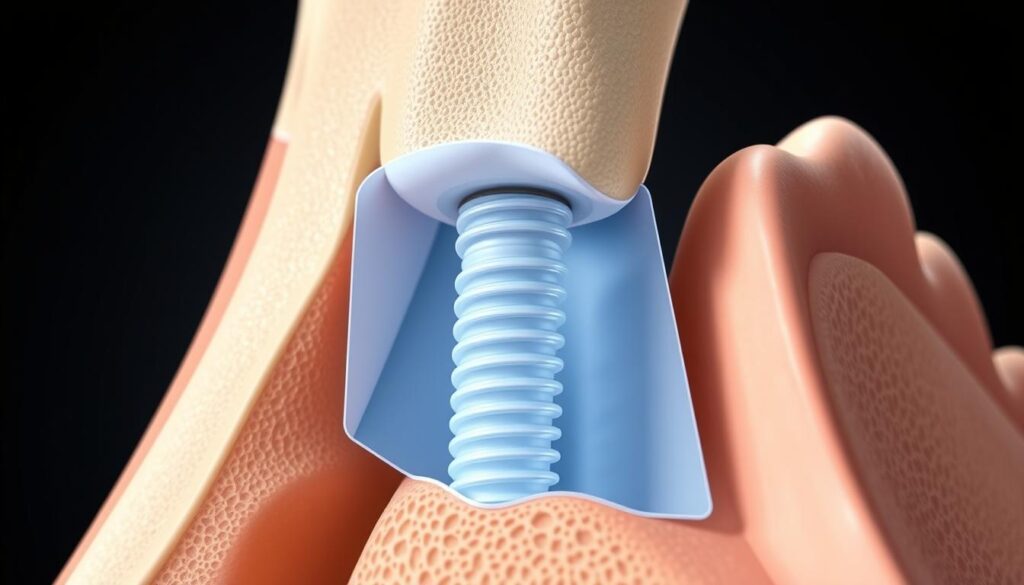Bone Graft for Implants: Why It’s Necessary

Every year, over 500,000 people in the United States get dental implants. But many don’t know about the key step of bone grafting. This step is vital for the success of dental implants. It helps rebuild the jawbone, ensuring the implant stays stable and lasts a long time. In the past, losing teeth was seen as permanent. But now, thanks to new medical techniques, we can fix the jawbone and avoid the effects of aging.
Why is a bone graft needed for implants? The reason lies under every smile. Losing teeth leads to jawbone loss, which can harm your other teeth and overall oral health. The jawbone needs the activity from tooth roots to stay healthy. Without this, the bone weakens, changing the way your face looks. A dental bone graft not only makes implant placement possible. It also brings back the strength of your mouth, giving you more than just a new smile.
Healing from a bone graft can take a lot of time, sometimes up to a year, to fully join with the jawbone. This shows how important the process is for the success of dental implants. For anyone thinking about getting dental implants, know that it starts with a bone graft. This prepares the way for your future smile.
Key Takeaways
- Over half a million people in the U.S. receive dental implants annually, often requiring bone grafts.
- Bone grafts are necessary to provide optimal jawbone support for successful dental implant integration.
- Dental bone grafting is a standard solution for jawbone loss, improving oral health and functionality.
- The healing process for bone grafts is integral, with initial healing taking about a week but full integration requiring up to a year.
- Understanding the importance of bone graft for dental implants is crucial for patients considering dental restoration.
Understanding Bone Grafting
Bone grafting is very important in dental surgery, especially when we talk about implants. This method helps fix the loss of bone, giving a strong base for implant installation.
The main goal here is to fix the jawbone so it can support new teeth. It’s not just about filling a gap. It’s about bringing back the bone’s strength and function.
What is Bone Grafting?
Bone grafting means putting bone in an area where the jawbone is lacking. This is crucial for people who don’t have enough natural bone due to tooth loss, injuries, or diseases. The aim is to build a solid base, much like the foundation of a building, which is vital for implant stability.
Types of Bone Grafts
There are different types of bone grafts used in dental work. The choice between autografts (from the patient’s own body), allografts (from a donor), or synthetic materials depends on the patient’s jawbone condition and the goal of the implant surgery.
How Bone Grafts Work
The bone grafting process for implants success depends a lot on the body accepting the graft. With time, the graft acts as a frame for bone regeneration for dental implants. This helps new bone to grow and eventually join with the existing bone. This process is key for the implants’ strength and function.
Bone grafting’s complex nature needs a good understanding and precise technique for the best outcomes. By using the body’s healing abilities, doctors can increase the chance of success for dental implants. This gives patients strong and long-lasting dental solutions.
The Role of Bone Density in Dental Implants
Having enough bone density is key for the success and lasting nature of dental implants. The jawbone plays a vital role, as it holds dental implants firmly. A strong link exists between bone density and implant success, affecting how well and how long implants last.
Dental implants need to bond well with jawbone, a process known as osseointegration. This bond relies heavily on the bone quality. So, it’s important to understand what affects bone density.
- Jawbone Structure: A good amount of bone mass ensures implants are well-supported. This is crucial to handle forces from daily actions like eating and speaking.
- Factors Affecting Bone Density: Age, food habits, genes, and lifestyle greatly impact bone health. Conditions like osteoporosis can also lower bone density, making dental implant processes harder.
Before dental implants, checking bone density is important. If bone density is low, bone grafts may be needed to improve the jawbone’s strength.
| Factor | Impact on Bone Density | Relation to Dental Implants |
|---|---|---|
| Age | Decrease in bone regeneration capability | Higher necessity for bone grafting |
| Nutrition | Poor nutrition can lead to weakened bone structure | Needs dietary intervention or supplementation |
| Lifestyle Choices | Smoking and alcohol usage severely impair bone quality | May require extended treatment plans |
| Osteoporosis | Significant bone density reduction | Often requires comprehensive bone grafting |
Addressing all bone density issues can make dental implants more successful. This makes implants a solid choice for those wanting to improve their dental health and looks.
Reasons for Bone Grafting
Bone grafting is key for dental implant success. It tackles oral health problems that weaken the jawbone. We look into the main reasons bone grafts are needed for bone density. Key issues include not enough bone volume, tooth loss effects, and gum disease. These need careful fixing.
Insufficient Bone Volume
Patients needing bone loss and dental implants often lack bone volume. This lack is due to osteoporosis, injuries, or birth defects. Bone grafts help add the needed bone density and volume. This makes dental implants more stable and long-lasting.
Previous Tooth Loss Impact
Lost teeth stop bone growth stimulation, leading to bone weakening. This weakens the jawbone, making implant placement hard. Bone grafting adds new tissue. This helps the jawbone recover, a big plus in benefits of bone grafting for implants.
Effects of Gum Disease
Gum disease can destroy bone around teeth. It’s bad for oral health and implant success. Bone grafting fixes periodontal disease damage. It builds up the bone, readying it for dental implants.
Bone grafts are must-haves in dental repairs. They prepare the jawbone for implants. Bone grafts are crucial for fixing erosion from tooth loss or gum disease damage. They greatly improve oral health outcomes.
The Bone Grafting Procedure
Bone grafting for dental implants is key to readying the jawbone for implants. It ensures the implants are strong, work well, and last long.
A deep check-up is first done to see if bone grafting is needed. This is the case when there’s not enough bone for implant procedures. If it’s needed, doctors plan the bone grafting carefully.
Steps Involved in Bone Grafting
To make the patient comfortable, doctors start with local anesthesia. Then, they add bone graft material, either from the patient or another source, to the bone. They secure the site, usually with a membrane, for good healing.
Local Anesthesia and Pain Management
Managing pain well is crucial in bone grafting. Local anesthesia cuts discomfort during the operation. After surgery, there are pain relief tactics to ease any soreness. Good pain management is key for recovery.
Recovery Process
Recovery after the operation is vital for the grafting to work. Patients must keep up with mouth cleanliness to dodge infections. They have regular check-ups to watch the healing progress.
They should eat soft foods at first to lower pressure on the treated area. It’s best to avoid hard activities that could harm the graft spot.
Being aware of each step helps patients in their healing. It is important. Patients should talk to their dentist to make sure the procedure and follow-up care go smoothly.
Risks and Considerations
Dental bone grafting usually works well. But it’s important to know it has risks, like any surgery. These risks include getting an infection, nerve damage, or the body not accepting the graft. Patients should talk to dentists in detail to see if they’re good candidates for this procedure. This means looking at your overall health, how much bone you’ve lost, and your dental needs. Also, think about the costs and recovery time, which can vary based on your health and how big the procedure is.
To see if bone grafting is right for you, doctors will check your medical and dental health. They’ll also want to know what you hope to achieve with future dental work. These checks are vital to make sure the procedure is safe and effective for you.
After learning about the risks, the next step is to talk with a specialist dentist. They will give you a risk assessment tailored to you. This helps you make a well-informed choice about the surgery.
- Infection control measures taken pre and post-operation
- Techniques used to minimize nerve damage
- Assurance measures against graft rejection
During your talk with the dentist, discuss how to lower risks and get the best results for your dental health.
Types of Bone Grafts for Dental Implants
Picking the right bone graft for dental implants matters a lot. There are many kinds to choose from, each fitting different needs. It is key for both patients and doctors to understand the choices. This includes knowing about autografts, allografts, and man-made bone substitutes.

Autografts are often seen as the best option. They use bone taken from the patient’s own body, like from the hip or chin. Autografts match the body well and have a low chance of being rejected. This means the healing and bonding happen quicker.
Allografts use bone from another person. This method avoids the need for two surgeries on the patient, which may make recovery easier and faster. To ensure the graft is safe and works well, allografts go through special processing.
Choosing synthetic bone materials is getting more popular. This is because they are always available and don’t need a second surgery spot. These products, like bioactive glasses and calcium phosphates, are designed to act like real bone. They encourage bone to grow and heal.
| Type | Source | Advantages | Common Use Cases |
|---|---|---|---|
| Autografts | Patient’s own body | High biocompatibility, lower rejection risk | Small to medium defects, critical aesthetic areas |
| Allografts | Donor bone | No secondary surgical site, good availability | Large bone defects, general implant preparations |
| Synthetic | Lab-engineered materials | Consistency in quality, no donor site morbidity | Various bone repair and augmentation cases |
In conclusion, choosing between autografts, allografts, and synthetic bone materials depends on many factors. These include the patient’s health history, how much bone is lost, and what the dental implant needs are. Each type has its own set of benefits. This makes them all very important for fixing bones and for dental implants.
The Importance of Timing
Finding the perfect time for optimal timing for bone grafting is key to dental implant success. This part dives into the timing of bone grafts and compares doing it now or later.
Dental implants need strong bones to hold them up, so when you do bone grafts is super important. If you graft right after a tooth is pulled, it has its perks. It stops bone loss and gets the site ready sooner.
But, sometimes you have to wait before grafting. Like if there’s an infection or a lot of bone is gone. Waiting helps fix these problems first. This means the whole implant thing takes longer, though.
| Type of Grafting | Advantages | Considerations |
|---|---|---|
| Immediate Bone Grafting | Reduces bone resorption, quicker implant process | Requires meticulous planning, suitable only in infection-free scenarios |
| Delayed Bone Grafting | Allows healing of area, addresses infections | Lengthens time until final implantation, potential for more bone loss |
Getting why immediate bone grafting for implants happens or choosing to delay is crucial. Dentists must look at each case closely. They think about health, bone status, and infections to plan the best time for grafting.
Success Rates of Bone Grafting
The success of bone grafting is key in regenerative medicine, especially for dental implants. Bone graft success rates are mostly high, but they depend on several important factors.

The patient’s health, their mouth hygiene, and the type of graft material matter a lot. Knowing these factors helps doctors and patients guess how well bone grafting will work.
| Factor | Impact on Success Rate |
|---|---|
| Patient’s Overall Health | Higher success rates in patients with good general health |
| Type of Bone Graft | Different materials can yield varying bone grafting outcomes |
| Surgeon’s Expertise | Experienced surgeons typically achieve more favorable results |
Studies show these factors are crucial. Careful planning and skilled dentists can really increase bone graft success rates. The table also explains how different things could change bone grafting outcomes.
Preparing for Bone Grafting
Getting ready for a bone graft means following certain bone grafting guidelines closely. This prep isn’t just about medical steps. It also includes knowing which meds and habits to avoid beforehand. Preparing well is key to making your bone graft work well and heal smoothly.
Doctors give important advice for the weeks before surgery. This includes what to eat, meds to stop, and how to arrange for help and a ride home after. It’s vital to stick to these recommendations to prevent problems and help healing.
It’s also crucial for patients to know which meds and supplements could harm the bone grafting process. The table below shows medications to avoid and some safer options, as oral surgeons usually suggest:
| Medication Type | Avoid | Alternative |
|---|---|---|
| Anti-inflammatory Drugs | Aspirin, Ibuprofen | Acetaminophen |
| Blood Thinners | Warfarin, Clopidogrel | Consult your doctor |
| Herbal Supplements | Ginkgo Biloba, St. John’s Wort | Discontinue use |
Talk to your doctor about your current meds to change or stop any that might slow healing or affect clotting. It’s crucial to focus on what to avoid as well as what to do before a bone graft. Following these guidelines is a smart way to make sure your graft is successful.
Post-Operative Care After Bone Grafting
Recovering fully from bone grafting is key to its success. It’s important to take care of yourself after the surgery to recover quickly and avoid problems. This care helps your bone grow strong around the graft area. We’ll cover what to expect and how to keep your mouth clean during recovery.
Recovery depends a lot on following the care instructions given after surgery. These steps help protect the graft and help the healing process. You’ll need to manage swelling, stop infections, and help new bone growth with the right habits and what you eat.
Immediate Post-Operative Actions: Use ice packs off and on for the first two days to lessen swelling. Take any prescribed medicines for pain and to reduce swelling as your doctor tells you.
Dietary Adjustments: Eat soft foods at first to not stress the graft area. Include foods high in vitamins and minerals to help healing.
Avoid Harmful Habits: Don’t smoke or drink alcohol. They can really slow down the healing process and hurt the bone graft.
It’s very important to keep your mouth clean after bone grafting. Rinse gently with warm salt water many times a day, especially after meals, to keep infection away. Brush carefully with a soft toothbrush, but stay away from the graft area.
These steps help make recovery smoother and set a strong base for any future dental work. Seeing your dentist regularly after the surgery is important. They can check on your healing and address any problems early, ensuring the bone graft works well for a long time.
Alternatives to Bone Grafting
Looking into other ways instead of bone grafting is key for those needing dental work but want to avoid its downsides. Newer methods now provide options that avoid the need for such invasive procedures. This is good news for patients wanting simpler solutions.
Non-graft dental implants are a great choice, offering a solid base for dental work without needing bone grafts. These implants work well even in cases where the bone isn’t thick enough, making them ideal for many. They help people get the dental care they need without the extra hassle.
Mini implants are another great option for those looking for less invasive dental work. They’re smaller, easier to place, and don’t usually require big surgeries. This means they’re also less expensive and help patients recover faster.
- Mini implants need only small cuts, making healing quicker and less painful.
- They’re perfect for securing dentures in people who can’t have regular implants.
- Mini implants fit into thinner bone areas without needing bone grafts.
These alternatives make dental care quicker and less stressful, keeping success rates high. It’s crucial to talk with a dental expert to figure out the best option. They can guide you on what will work best for your dental health and needs.
The move towards options like non-graft dental implants marks a big change in dental care. It focuses on making patients more comfortable and letting them heal faster while still getting great results.
Choosing the Right Specialist
Choosing the right bone graft specialist is super important. You need a qualified dental surgeon to make sure everything goes well. A skilled dental surgeon knows a lot and understands what each patient needs. This helps them make a custom plan for you.
-
- Finding a Qualified Dental Surgeon
To find a good dental surgeon, look at their skills and experience. Check their board certifications, how long they’ve been working, and if they’ve got special training in bone grafting. It’s also smart to read reviews from other patients and look at the doctor’s past work.
-
- Questions to Ask Before the Procedure
Before you pick a bone graft specialist, think of questions to ask. You should know how many bone grafts they’ve done, what materials they use, and how long recovery takes. This will help you know what to expect and make you feel more at ease.
Choosing the right dental surgeon is really important. It’s not just about how things go right after the surgery, but also your mouth’s health in the future. Make sure your surgeon is well-trained and has a good history of helping patients.
Costs Involved with Bone Grafting
Learning about the costs of bone grafting is vital for anyone thinking about the surgery. The price can change a lot depending on a few things. These include what kind of graft is used, how complex the surgery is, and where it’s done. Also, what your insurance covers can vary a lot between different companies and plans.
The average cost of bone grafting is crucial for people getting ready for it. It can be anywhere from a few hundred to several thousand dollars. Using your own bone, called an autograft, usually costs more. This is because it’s harder to take out and put in. On the other hand, man-made grafts could be cheaper.
It’s just as key to look into bone graft insurance coverage. Some insurances might pay for the whole thing, but others might not pay as much. It’s a good idea to check your insurance benefits carefully. Or, you could talk straight to your insurance company to know what they’ll pay for.
It’s important for patients to think about these things and talk with their dentists. This helps plan better and clear up any worries about costs. Knowing all about the bone grafting costs and insurance details helps make smart health choices.
Long-Term Outcomes of Bone Grafting
Bone grafts are key for the success of dental implants and maintaining oral health. They not only support the structure needed for implants. They also help keep the mouth healthy for a long time. This shows the critical role of bone grafting in oral health and implant success.
Getting to know the long-term advantages of bone grafting is important. It helps see how it makes dental implants succeed and keeps oral health good. Let’s look into these important points.
Benefits for Dental Implant Success
Studies over many years show how important jawbone quality is for implant success. Bone grafting gives the needed base by adding bone where it’s missing. It also helps grow bone around the implant. This strong bond makes the implant work better. People enjoy better chewing and speaking, and their faces look better too.
Maintaining Oral Health After Grafting
After a bone graft, it’s vital to keep the mouth healthy. A successful graft reduces the chance of bone loss, a big issue after losing teeth. Preserving the jawbone lessens the risk of other teeth moving or losing more teeth. So, keeping oral health isn’t just about stopping problems. It’s also about making the mouth healthy for a long time.
Here’s a closer look at how good bone grafting links to ongoing benefits for the mouth:
| Outcome | Importance to Oral Health | Relation to Bone Grafting |
|---|---|---|
| Improved Bone Stability | Supports dental implants and keeps teeth aligned | Comes directly from successful grafting |
| Decreased Bone Resorption | Stops further oral issues | A helpful step due to grafting |
| Enhanced Aesthetic Outcome | Keeps the face looking right | Makes facial tissues better after grafting |
This comparison shows the deep value of bone grafting. It’s both a key step for implants and a way to keep the mouth healthy over time.
Conclusion: The Necessity of Bone Grafting
Throughout this article, we’ve looked closely at how crucial bone grafting is for dental implant success. We talked about different types of grafts, the best time for the surgery, and what patients should expect during recovery. Bone grafting is a key part of dental care, especially if you’re dealing with low bone density and need stable, durable implants.
From what we’ve covered, it’s clear that bone grafting isn’t optional. It’s needed for implants to work well in the long run. This complex process strengthens the jawbone. That way, it can support an implant that might greatly boost a patient’s life quality.
Thinking about getting bone grafting? It’s vital to talk with dental pros. Since everyone’s needs differ, individual treatment plans are a must. We urge you to find trusted dental experts. They can guide you, answer your questions, and make bone grafting as safe and successful as possible. Following the wise teaching path, our goal stays to push forward regenerative medicine research. This helps grow our understanding and solutions for big health issues.


